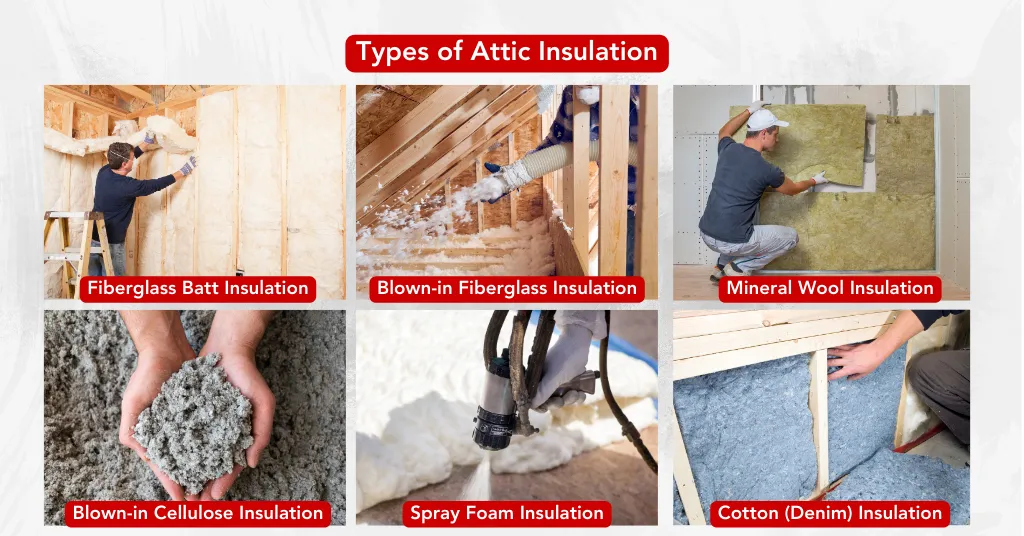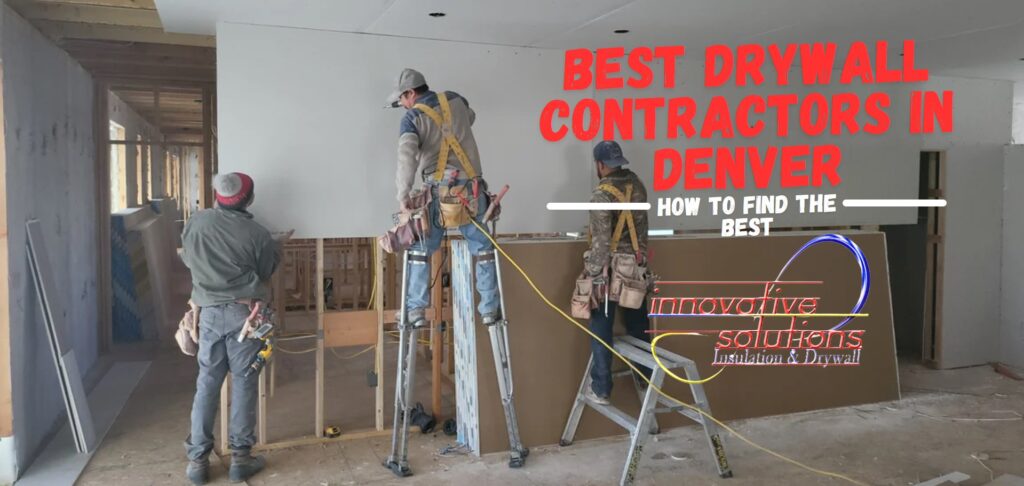Denver has a semi-arid climate with hot summers and freezing winters. Low-quality attic insulation leads to unwanted air drafts in summer and warm air leaking in winter, increasing energy bills. Therefore, Denver homes require insulation with a higher R-value to maintain indoor temperatures.
To address these insulation issues, homeowners often need help choosing among the best types of attic insulation in Denver.
Let me walk you through various attic insulation options and help you find a suitable solution.
History of Insulation
Insulation began with natural materials like straw, mud, and animal skins to insulate dwellings from extreme temperatures.
During the Industrial Revolution, the demand for insulation grew with urbanization and modern construction. So, homeowners and builders started using different types of insulation materials in Dever, like sawdust, newspapers, and horsehair.
In 1938, Owens Corning introduced fiberglass insulation due to its effectiveness and relatively low cost. However, mineral wool (rock wool) became popular for fire resistance and soundproofing efficiencies.
These advancements, followed by the introduction of blow-in fiberglass and cellulose insulation, provided even better sealing and improved thermal efficiency in attics and walls. Besides, in the 1960s, industries started using spray foam insulation due to its higher R-value and energy efficiency.
Types Of Attic Insulation And Their Unique Properties

Since the late 20th century, several insulation materials have been used to insulate attics in Colorado homes. However, every type of insulation material in Denver has distinctive properties. So, let’s get to know each of them one by one.
Fiberglass Batt Insulation
It is made from light and combustible woven glass material. These spun glass fibers are DIY-friendly and come in pre-cut batts with a paper or foil facing. So, Colorado homeowners can easily fit batts between wall studs while securing them with wire or tape.
Mineral Wool
Mineral wool insulation is produced by melting minerals like rock or slag at high temperatures and spinning them into fibers. These fibers are then formed into batts or used as loose fill. However, its installation requires careful handling to ensure consistent density.
Denim Insulation
It’s an eco-friendly insulation material prepared by using recycled denim jeans fabric. It is also sold in batts or rolls that are easy to install.
Blown-in Fiberglass Insulation
This fiberglass insulation is blown into walls, attics, or floors using a machine. However, it’s a skin-sensitive material prepared in industries and needs specialized equipment for installation. Although it’s fiberglass, it provides better gap sealing.
Blown-in Cellulose
Cellulose insulation is derived from recycled paper and blown into walls, attics, or floors. It is an eco-friendly insulation material treated with borate and other chemicals. These chemicals make it insect-repellent and fire-resistant. However, for better moisture resistance, a water splash method is used by professionals.
Spray Foam Insulation
Spray foam is a mixture of isocyanate and polyol that is the most suitable attic insulation for irregular spaces, crevices, and cracks. It expands to fill gaps and then hardens into a rigid foam. However, it’s not DIY-friendly and needs professional installation.
Looking for Drywall or Insulation Services in the Denver Area and Beyond?

Pros And Cons Of Various Attic Insulations In Denver:
Every material has different properties, leading to certain benefits and drawbacks. However, upon careful consideration, you can take preventive measures for long-term energy benefits.
| Types | Pros | Cons |
|---|---|---|
| Fiberglass Batt Insulation | Moisture and fire resistance Easy installation | It can be itchy to handle without proper protective gear leaving gaps if not installed properly |
| Mineral Wool | Natural fire barrier Continues to insulate when wet Great sound blocker | Scarce and hard to find More expensive compared to fiberglass |
| Denim Insulation | Made from recycled materials (eco-friendly) Good thermal and acoustic insulation | Very expensive |
| Blown-in Fiberglass Insulation | Fills in cracks and voids around obstructions Cost-effective Moisture and fire resistance | Loses R-value at extremely low temperatures Itchy to handle and may leave gaps upon sub-par installation |
| Blown-in Cellulose | Cost-effective Higher R-value than most fiberglass Rodent and insect repellent due to boric acid | Retains water leading to mold and mildew |
| Spray Foam Insulation | High R-value (up to 7) Long-lasting Airtight seals Impermeable to water Strengthens structure | Extremely expensive Permanent once installed Requires professional installation |
ISID has a knowledgeable team for attic insulation. We know the pros and cons of the types of attic insulation material in Denver and provide necessary solutions to handle future issues. If you consult our expert installation team, they will resolve your insulation-related problems.
R-value Requirements And Cost Comparison:
R-value, measured in resistance per inch, indicates an insulation material’s ability to resist heat flow. Considering the climate, Denver building codes recommend higher R-values of R-38 to R-60 for better thermal regulation.
However, different types of attic insulation in Denver provide a different level of thermal resistance. Therefore, you should choose insulation materials with a higher R-value per inch. Likewise, you can install thicker layers of lower R-value materials to achieve the required total R-value, but it will affect cost.
Let’s check the R-value and costs of each material.
| Insulation Type | R-value per inch | Cost per square foot(approx.) |
|---|---|---|
| Fiberglass Batt Insulation | 2.9 - 3.8 | $0.88 to $1.64 |
| Mineral Wool | 3.0 - 3.3 | $0.80 - $1.45 |
| Denim Insulation | 3.5 - 4.0 | $1.80 - $2.45 |
| Blown-in Fiberglass Insulation | 2.2 - 2.7 | $0.50 - $1.10 |
| Blown-in Cellulose Insulation | 3.2 - 3.8 | $0.60 - $1.80 (add 0.2-0.5 for wet spray) |
| Spray Foam Insulation | 6.0 - 7.0 | $1.50 to $4 |
Well, don’t get caught in this complicated calculation. My team at ISID can do the math for you and create a budget-friendly plan for highly energy-efficient insulation for your attic.
Environmental Effects of Insulation Material
Most insulation materials are prepared using non-eco-friendly materials and high amounts of fossil energy. However, attic insulation itself is an energy-saving process. The better the insulation, the less you depend on the HVAC system. As a result, you will save energy in the long term.
Moreover, some eco-friendly materials like cellulose and denim insulation are also available. These insulation materials are made from recycled materials and significantly reduce carbon footprint.
At ISID, we prioritize insulation solutions that balance sustainability and under budget. Our team considers the environmental impacts of each material to help you make informed decisions for a greener home.
People Also Ask
What Type of Attic Insulation Is Best?
The best attic insulation depends on your needs. Spray foam offers the highest R-value, while blown-in cellulose is eco-friendly and cost-effective for Denver’s climate.
What Are 4 Common Types of Insulation?
Four common insulation types are fiberglass batt, mineral wool, blown-in fiberglass, and spray foam. Each has distinct properties suitable for different needs.
What Is Attic Insulation?
Attic insulation is a material installed in attics to reduce heat loss in winter and heat gain in summer, improving energy efficiency and comfort.
What Are the Pros and Cons of Blown-In Fiberglass Insulation?
Pros: Fills cracks, cost-effective, moisture and fire-resistant. Cons: Itchy to handle, may lose R-value in extreme cold, and requires proper installation to avoid gaps.
All types of attic insulation in Denver can be used for the homes. However, you must be careful with the installation and pre-installation process. For instance, installing fiberglass without treating leakages and cracks will lead to mold growth.
Moreover, ignoring the material thickness of spray foam can result in low-level temperature resistance.
Contact ISID for affordable insulation plans and professional service.




